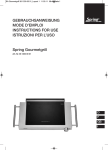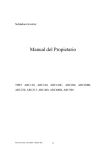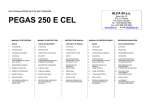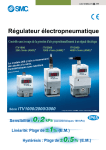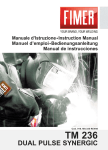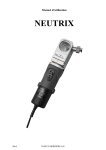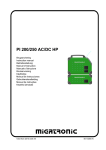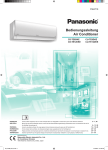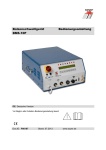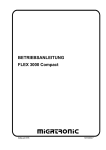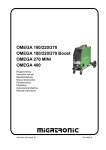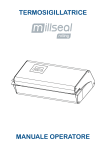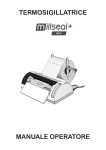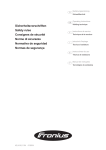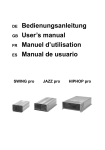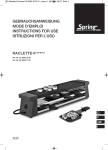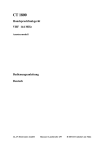Download GREEN 130 E / 160 E
Transcript
GREEN 130 E / 160 E Instruction manual Manuale d'istruzione Betriebsanleitung Manuel d’instruction 0651 50113128 D GB – CONTENTS : - Warning / Electromagnetic disturbances ............................... 3 General description ................................................................ 4 Initial operation ....................................................................... 6 Initial instructions / Maintenance ............................................ 8 Fault location .......................................................................... 9 Technical specifications / Circuit diagram ............................ 10 Spare parts list...................................................................... 35 I – INDICE : - Attenzione / Emissioni elettromagnetiche ............................ 11 Descrizione generale............................................................ 12 Operazioni iniziali ................................................................. 14 Istruzioni iniziali / Manutenzione........................................... 16 Ricerca guasti ....................................................................... 17 Dati tecnici / Diagrammi circuitali ......................................... 18 Elenco parti di ricambio ........................................................ 35 D – INHALTSVERZEICHNIS : - Warnung / Elektromagnetische Störungen .......................... 19 Allgemeine Beschreibung .................................................... 20 Inbetriebnahme .................................................................... 22 Bedienung / Wartung ........................................................... 24 Fehlersuche .......................................................................... 25 Technische Daten / Koppeldiagramm .................................. 26 Ersatzteilliste ........................................................................ 35 F – INDEX : - Avertissement / Emission de bruit électromagnétique ......... 27 Description générale ............................................................ 28 Operation initiale................................................................... 30 Instruction initiale / Maintenance .......................................... 32 Localisation d’erreur ............................................................. 33 Données techniques / Diagramme de circuit ....................... 34 Liste des pièces de rechange .............................................. 35 EC DECLARATION OF CONFORMITY Greenweld by Svejsemaskinefabrikken Migatronic A/S, Aggersundvej 33, 9690 Fjerritslev, Denmark hereby declare that our machine as stated below Type: As of: conforms to directives: European Standards: GREEN 130 E / 160 E week 21, 2005 73/23/EEC and 89/336/EEC EN/IEC60974-1 EN/IEC60974-10 Issued in Fjerritslev on 24th May 2005. Peter Roed Managing director ENGLISH WARNING Arc welding and cutting can be dangerous to the user, people working nearby, and the surroundings if the equipment is handled or used incorrectly. Therefore, the equipment must only be used under the strict observance of all relevant safety instructions. In particular, your attention is drawn to the following: Electricity - The welding equipment must be installed according to safety regulations and by a properly trained and qualified person. The machine must be connected to earth through the mains cable. - Make sure that the welding equipment is correctly maintained. - In the case of damaged cables or insulation, work must be stopped immediately in order to carry out repairs. - Repairs and maintenance of the equipment must be carried out by a properly trained and qualified person. - Avoid all contact with live components in the welding circuit and with electrodes and wires if you have bare hands. Always use dry welding gloves without holes. - Make sure that you are properly and safely earthed (e.g use shoes with rubber sole). - Use a safe and stable working position (e.g. avoid any risk of accidents by falling). Light and heat emissions - Protect the eyes as even a short-term exposure can cause lasting damage to the eyes. Use a welding helmet with suitable radiation protection glass. - Protect the body against the light from the arc as the skin can be damaged by welding radiation. Use protective clothes, covering all parts of the body. - The place of work should be screened, if possible, and other persons in the area warned against the light from the arc. Welding smoke and gases - The breathing in of the smoke and gases emitted during welding is damaging to health. Make sure that any exhaust systems are working properly and that there is sufficient ventilation. Fire hazard - Radiation and sparks from the arc represent a fire hazard. As a consequence, combustible materials must be removed from the place of welding. - Working clothing should also be secure against sparks from the arc (e.g. use a fire-resistant material and watch out for folds and open pockets). - Special regulations exist for rooms with fire- and explosion hazard. These regulations must be followed. Noise - The arc generates acoustic noise according to welding task. In some cases, use of hearing aids is necessary. Dangerous areas - Special consideration must be taken when welding is carried out in closed areas or in heights where there is a danger of falling down. Positioning of the machine - Place the welding machine so there is no risk that the machine will tip over. - Special regulations exist for rooms with fire- and explosion hazard. These regulations must be followed. Use of the machine for other purposes than it is designed for (e.g. to unfreeze water pipes) is strongly deprecrated. If occasion should arise this will be carried out without responsibility on our part. Read this instruction manual carefully before the equipment is installed and in operation Electromagnetic emissions and the radiation of electromagnetic disturbances 7. The time of day that welding and other activities are to be carried out. 8. The structure and use of buildings. If the welding equipment is used in a domestic establishment it may be necessary to take special and additional precautions in order to prevent problems of emission (e.g. information of temporary welding work). Methods of reducing electromagnetic emissions: 1. Avoid using equipment which is able to be disturbed. 2. Use short welding cables. 3. Place the positive and the negative cables close together. 4. Place the welding cables at or close to floor level. 5. Remove signalling cables in the welding area from the supply cables. 6. Protect signalling cables in the welding area, e.g. with selective screening. 7. Use separately-insulated mains supply cables for sensitive electronic equipment. 8. Screening of the entire welding installation may be considered under special circumstances and for special applications. This welding equipment for industrial and professional use is in conformity with the European Standard EN/IEC60974-10. The purpose of this standard is to prevent the occurrence of situations where the equipment is disturbed or is itself the source of disturbance in other electrical equipment or appliances. The arc radiates disturbances, and therefore, a trouble-free performance without disturbances or disruption, requires that certain measures are taken when installing and using the welding equipment. The user must ensure that the operation of the machine does not occasion disturbances of the above mentioned nature. The following shall be taken into account in the surrounding area: 1. Supply and signalling cables in the welding area which are connected to other electrical equipment. 2. Radio or television transmitters and receivers. 3. Computers and any electrical control equipment. 4. Critical safety equipment e.g. electrically or electronically controlled guards or protective systems. 5. Users of pacemakers and hearing aids etc. 6. Equipment used for calibration and measurement. 3 GENERAL DESCRIPTION GREEN 130E/160E is a monophased welding machine based on the Power Mosfets technology. It has been constructed especially for those applications where welding jobs must be completed quickly and easily. Using the latest inverter technology, GREENWELD has designed and produced a compact welding machine able to weld with all types of electrodes (not high-yield electrodes) at currents up to 130/160 amps. The combination of low weight and compact design makes the GREEN 130E/160E extremely suitable for installation work, field construction, emergency repairs, etc. The electronics of the machine will keep the welding current stable at the set level by automatically readjusting mains voltage and load variations. GREEN 130E/160E is very easily operated since it is only fitted with one knob for infinitely variable adjustment of the welding current from 10-130 A on GREEN 130E and 20-160 A on GREEN 160E. The block diagram illustrates the principle of the machine. Switch driver REGULATOR REF CONTROL The machine is equipped with the following fixed functions: Hotstart: This auxiliary function helps to establish the arc when MMA welding starts. This is done by increasing the welding current (when the electrode touches the workpiece) compared to the set welding current. This function facilitates the ignition of the electrode and results in quicker and better welding. Arc control: When arc and weld pool have been established, this function will ensure that the arc is kept stable, and that the result will be a more uniform welding. Static characteristic Static Characteristic U2 [V] 60 50 40 Green 130E Green 160E Norm line 30 20 10 I2 [A] 0 0 20 40 60 80 100 120 140 160 180 The static characteristic graph illustrates that the machine performs up to 130A/160A at 26V. The high performance of the machine presupposes a mains voltage of not less than 230V. 4 Pay attention to the fact that application of extention cables reduces the maximum performance of the machine. Also electrodes with a higher working voltage than the specific arc characteristic will reduce the maximum welding current. Contact your local GREENWELD dealer for further advice about: - Personal safety Environment Consumables etc. Dispose of the product according to local standards and regulations. www.migatronic.com/goto/weee 5 INITIAL OPERATION Mains connection After connection of the mains cable the machine is ready for use. Please note that all cable connections must be made by authorized and qualified staff. Type GREEN 130E GREEN 160E Mains Voltage 230V 230V Fuse 16A 1) 20A(16A) Mains cable 2 3x2.5mm 2 3x2.5mm 1) With connection to low voltage mains network only 16A (schuko plug) The machine will function optimally and satisfactorily if voltage is kept above permissible minimum voltage. Therefore, it is important to pay attention to the fact that any extension of mains cables or welding cables will reduce the maximum performance of the machine. This is caused by the fact that the electrical resistance of the cable will cause a decline in voltage, which is directly dependent on the length of the cable. See ”Technical data”. Warning! There is an imminent danger of damaging the extension cable if it is coiled during use of the machine, since the cable will not be cooled sufficiently. The extention cable must not, at the same time, be used for the supply of any other equipment. Connection of welding cables Connect the welding cables to the front of the machine. Please note that the plug must be turned through 45 degrees after insertion into the socket. If the plug is not installed correctly, it will be damaged due to excessive contact resistance, and as a consequence the machine will be damaged too. Configuration GREENWELD disclaims all responsibility for damaged cables and hoses and other damage related to welding with an undersized welding torch and welding cables measured by welding specifications e.g. in relation to permissible load. Warning Connection to generators can damage the welding machine. When connected to a welding machine, generators can produce large voltage pulses, which can damage the welding machine. Use only frequency and voltage stable generators of the asynchronous type. Defects on the welding machine arisen due to connection of a generator are not included in the guarantee. Usage of the machine When welding with a GREEN 130E/160E machine, some heating of various components of the machine takes place and during breaks in welding these components will cool down again. It is not possible to overload the machine in normal use, and the machine can work continuously at current settings up to 85A for GREEN 130E and 100A for GREEN 160E during MMA electrode welding. If the machine is set for currents higher than 85A/100A, there will be a need for periods during which the machine can cool down. Higher current and higher ambient temperature will result in longer cooling periods. 6 The length of the cooling periods depends on the current setting, and the machine should not be interrupted during cooling. If the cooling periodes during use of the machine are not sufficiently long, the overheating protection will automatically interrupt the welding process. The yellow LED will alight and thus indicates that the machine has been disconnected due to overload. The LED switches off when the machine has cooled down sufficiently. The permissible load can be seen from the paragraph "Technical data". Example: 60% max. load when MMA welding means that a cooling period of four minutes after welding for six minutes is required at a current setting of 120 A; this calculation presupposes 10 minutes between the start of each welding period. The machine has been specially designed for simple welding jobs and is therefore not intended to work with high loads over a long period of time. Mobility The carrying handle of the machine is strong enough to be used for movement or carriage, including lifting by hoist or crane. During operation the machine must not be carried around or fixed to a person. Positioning Due to its low centre of gravity the machine can also be placed on tilted bedplates; during its operation, however, the machine should be placed in a way that will ensure that pulling of the welding cables will not cause the machine to tip over. It must be made sure that the air intake and outlet are not blocked, and the machine must not be placed in a position that will obstruct the circulation of cooling air. (See also ”Permissible ambient temperature” under ”Technical data”). When used on scaffoldings and the like, the machine must be fastened properly. The handle may be used for this purpose. GREENWELD disclaims all responsibility, if the machine is used for any purpose other than welding. 7 INITIAL INSTRUCTION Generally 1. Main switch This switch turns the machine on and off. 2. Mains cable Entry point for mains voltage supply cable 3. Welding cable sockets DC positive and negative welding current outlet sockets. Electrode cable to be fitted in positive or negative outlet socket in conformity with the polarity of the electrode, and earth return cable to be placed in remaining socket. 4. Welding current control This knob is used for adjustment of the welding current. The welding current is adjustable from 10-130A on GREEN 130E and 20-160A on GREEN 160E. 5. Overheating The yellow LED will alight if the machine is disconnected due to overheating. Overheating arises if the machine is overloaded. The machine automatically reconnects when the temperature has fallen, and the yellow LED will switch off. Warning: When the machine is overheated, it is important to place the electrode holder/torch so as to avoid the risk of establishing the arc when the machine reconnects automatically. MAINTENANCE GREEN 130E/160E requires virtually no maintenance. However, exposure to extremely dusty, damp or corrosive air is damaging to the welding machine and in order to prevent problems arising, the following procedure should be observed at least once a year or as occasion requires: - disconnect the machine from the incoming mains supply - clean the cooling ribs with compressed air or a soft brush without taking the machine apart. Lack of maintenance can lead to reduced reliability and cancellation of the guarantee. Please note that the guarantee will no longer apply if it has been attempted to take the machine apart or to open the factory-made sealing of the machine. 8 FAULT LOCATION Repairs must only be carried out by Greenweld staff. Fault symptoms: The machine does not work: There may be no mains supply or the mains fuse is damaged. Check that both mains supply and mains fuse are intact. Check that welding cables are correctly mounted in the plugs. Check that the cables are not defective and that there is sufficient earth connection as close as possible to the workpiece to be welded. Overheat: The yellow LED will alight, if the machine is overloaded. This occurs - if welding with a higher load than permitted, - if the machine requires cleaning, or - if the air intake and/or outlet of the machine is completely or partially blocked. Check that the machine is not overloaded, cf. ”Technical data” and/or clean cooling ribs by use of clean, dry compressed air after disconnecting the machine from the incoming mains supply. The machine does not produce maximum welding output: Check the mains voltage being connected to the machine. Performance depends on correct mains voltage. Voltage is measured where the machine is connected to any extension cables. It may be caused by the fact that the machine is connected with too long cables, and if possible, only primary and secondary cables should be reduced as much as possible. The machine switches off, but not because of overheating: Too low or unstable mains voltage which may be combined with the use of too long or too thin extension cable. Check mains voltage and connection. If rectification of the fault is not possible: Contact your dealer – the machine may be defective 9 TECHNICAL DATA Type GREEN 130E GREEN 160E 1x230 V ± 10% 16 15.0 27.4 3.5 6.3 <35 0.85 1 1x230 V ± 10% 1 20 (16) 20.1 35.0 4.6 8.1 <35 0.85 1 V A A A kVA kVA W 25 – 130 85 (100) 90 (110) 30 – 160 100 (120) 120 (150) 160 A A A A A V Mains voltage Fuse Mains current, effective Mains current max. Consumption, 100% Consumption, max. Consumption, open circuit Efficiency Cos.phi Current range DC Duty cycle, 100% Duty cycle, 60% Duty cycle, 30 (35)% Duty cycle, 15 (20)% Open circuit voltage 40 (20) °C 40 (20) °C 40 (20) °C 40 (20) °C 130 55 – 60 55 – 60 IP21 IP21 2 Protection class 3 Application class Standards Extension cable Electrode diameter Dim. HxWxL Weight S S EN/IEC60974-1 EN/IEC60974-10 min. 2.5 mm², max. 30 m 1.6 – 3.25 300 x 140 x 220 6.5 EN/IEC60974-1 EN/IEC60974-10 min. 2.5 mm², max. 30 m 1.6 – 3.25 370 x 160 x 250 8.5 mm mm kg Circuit diagram SW1 P1 1 D D + OUT+ A 4 2 3 SW1 OUTP2 +24V 1 C C 4 2 3 +24V P1 EI-25 11 LM7812 +12V 23 GREEN 1 VINT VOUT GN 2D 3 1 27 B B +24V 15 B-XQDB PK-02-A0 29 21 30 25 13 10 9 2 6 4 +12V P2 +24V XH-02 A A RED 2 1 10K 10K Title VH-02 Size 2 1 1 2 3 GREEN 130E/160E Revision B Date: File: 1 Number 2 3 4 5 2-Sep-2004 Sheet of Drawn By: 6 With connection to low voltage mains network only 16A (schuko plug) IP21: For indoor application. The machine must be protected against precipitation in outdoor application. S This machine meets the demands made for machines which are to operate in environments with an increased hazard of electric shocks. 10 ITALIANO ATTENZIONE Le macchine per saldatura e taglio possono causare pericoli per l'utilizzatore, le persone vicine e l'ambiente se l'impianto non e' maneggiato o usato correttamente. La macchina pertanto deve essere usata nella stretta osservanza delle istruzioni di sicurezza. In particolare e' necessario prestare attenzione a quanto segue: Elettricita' - L'impianto di saldatura deve essere installato in accordo alle norme di sicurezza vigenti e da personale qualificato. La macchina deve essere collegata a terra tramite il cavo di alimentazione. - Assicurarsi che l'impianto riceva una corretta manutenzione. - In caso di danni ai cavi o all'isolamento il lavoro deve essere interrotto immediatamente per eseguire le opportune riparazioni. - La riparazione e la manutenzione dell'impianto deve essere eseguita da personale qualificato. - Evitare ogni contatto a mani nude con componenti sotto tensione nel circuito di saldatura e con fili ed elettrodi di saldatura. Usare sempre guanti di saldatura asciutti ed in buone condizioni. - Assicurarsi di usare indumenti di sicurezza (scarpe con suola di gomma etc.). - Assumere sempre una posizione di lavoro stabile e sicura (per evitare incidenti e cadute) Emissioni luminose - Proteggere gli occhi in quanto anche esposizioni di breve durata possono causare danni permanenti. Usare elmetti di saldatura con un adeguato grado di protezione. - Proteggere il corpo dalle radiazioni che possono causare danni alla pelle. Usare indumenti che coprano tutto il corpo. - Il posto di lavoro deve essere, se possibile, schermato e altre persone che operano nell'area devono essere avvertite del pericolo. Fumi di saldatura e gas - La respirazione di fumi e gas emessi durante la saldatura e' dannosa per la salute. Assicurarsi che gli impianti di aspirazione siano funzionanti e che ci sia sufficiente ventilazione. Incendio - Le radiazioni e le scintille dell'arco rappresentano un pericolo di incendio. Il materiale combustibile deve essere rimosso dalle vicinanze. - Gli indumenti utilizzati devono essere sicuri contro le scintille dell'arco (usare materiale ignifugo, senza pieghe o tasche). - Aree a rischio di incendio e/o esplosione sono soggette a specifiche regole di sicurezza: queste regole devono essere seguite rigorosamente. Rumorosita’ - L’arco genera un rumore superficiale a seconda del procedimento usato. In alcuni casi puo’ essere necessario adottare una protezione per l’udito. Aree Pericolose - Prestare particolare attenzione quando si opera in ambienti chiusi o poco ventilati o ad altezze dal suolo tali da costituire pericolo di caduta. Posizionamento della macchina - Collocare la macchina sul piano, in posizione stabile, per evitarene il rischio di ribaltamento. - Aree a rischio di incendio e/o esplosione sono soggette a specifiche regole di sicurezza: queste regole devono essere seguite rigorosamente. L’uso di questo impianto per finalita’ diverse da quelle per le quali e’ stato progettato, ad esempio scongelamento di condotte d’acqua etc, e’ assolutamente vietato. In tal caso la responsabilita’ dell’operazione ricade interamente su colui che la esegue. Leggere questo manuale di istruzioni attentamente prima di installare e mettere in funzione l'impianto Le emissioni elettromagnetiche e le radiazioni da disturbi elettromagnetici In conformità con le Direttive di Compatibilità Elettromagnetica (EMC) entro l'Unione Europea, questa macchina di saldatura di alta qualità per l'uso professionale e industriale è progettata, realizzata e collaudata in accordo con lo Standard Europeo EN/IEC60974-10, riguardante le radiazioni e gli incidenti da radiazioni date da disturbi elettromagnetici; lo scopo di questo standard è la prevenzione di fatti e situazioni nelle quali la macchina viene disturbata oppure è essa stessa fonte di disturbo verso altre apparecchiature elettriche. L'arco elettrico irradia disturbi e per una prestazione senza inconvenienti o disturbi causati da emissioni elettromagnetiche, si richiede il rispetto di alcune misure durante l'installazione e l'utilizzo della macchina. E' pertanto responsabilità dell'utilizzatore assicurare che l'uso di questa macchina non sia fonte di disturbi di tale natura. E' necessaria una valutazione dell'area circostante, valutando i seguenti punti: 1. Cavi di alimentazione per altre apparecchiature, cavi di controllo, cavi segnale e telefonici nelle vicinanze della macchina. 2. Trasmettitori e ricevitori radiotelevisivi. 3. Apparecchiature di controllo e computers. 4. Apparecchiature di sicurezza critiche, come ad esempio allarmi elettrici ed elettronici o sistemi di protezione per apparecchiature di processo. 5. Motivazioni di salute del personale presente nell'area, ad esempio utilizzatori di pacemakers, apparecchiature per l'udito, ecc .. 6. Apparecchiature di taratura e misura. 7. Gli orari della giornata nei quali si prevede di saldare. 8. La struttura e la destinazione dell'edificio. Nel caso la macchina venisse usata in abitazioni il rischio di disturbare altre apparecchiature elettriche cresce e potrebbe essere necessario assumere precauzioni aggiuntive speciali in modo da prevenire problemi di emissione (ad esempio Avvisi di Lavoro Temporaneo). Metodi di riduzione delle emissioni elettromagnetiche I cavi di saldatura devono essere tenuti i più corti possibile. 1. Evitare l'utilizzo di apparecchiature sensibili ai disturbi 2. Usare cavi di saldatura il piu' corti possibile. 3. Posizionare i cavi di saldatura in modo che positivo e negativo siano vicini. 4. Posizionare i cavi di saldatura distesi sul pavimento o il piu' vicino possibile ad esso. 5. Separare i cavi di segnale da quelli di saldatura 6. Proteggere con schermature i cavi di segnale 7. Utilizzare cavi di alimentazione isolati e separati per apparecchiature elettroniche sensibili, ad esempio computers. 8. In speciali circostanze puo' essere necessario schermare l'intero impianto contro le emissioni elettromagnetiche. 11 DESCRIZIONE GENERALE GREEN 130E/160E è una macchina di saldatura monofase basata sulla più avanzata tecnologia dei Mosfet di potenza. E’ stata progettata specialmente per quelle applicazioni nelle quali sia richiesto un lavoro di saldatura veloce e facile. Utilizzando la più recente tecnologia inverter, la Greenweld ha sviluppato una macchina compatta, ed in grado di saldare con tutti i più comuni tipi di elettrodo (escluso elettrodi ad alto rendimento) fino ad una corrente di 130/160 Amp. La combinazione della compattezza e del basso peso rende GREEN 130E/160E ideale per i lavori di installazione, montaggio, riparazione etc. Il controllo elettronica della macchina mantiene stabile la corrente erogata, compensando eventuali variazioni di tensione di alimentazione o di carico. GREEN 130E/160E sono facilissimi da regolare in quanto la corrente può essere variata da 10 a 130 A sullo GREEN 130E e da 20 a 160 A sullo GREEN 160 tramite un potenziometro. Il diagramma a blocchi illustra il principio di funzionamento dell’impianto. Switch driver REGULATOR REF CONTROL La macchina e’ dotata delle seguenti funzioni preimpostate : Hotstart : Questa funzione ausiliaria facilita l’innesco in saldatura da elettrodo. Quando l’elettrodo tocca il pezzo da saldare la corrente sale ad un valore superiore a quello impostato sulla macchina e l’innesco ne risulta facilitato. Controllo dell’arco : Quando l’arco si e’ acceso, questa funzione assicura che rimanga stabile con un risultato di saldatura più uniforme. Caratteristica statica Static Characteristic U2 [V] 60 50 40 Green 130E 30 Green 160E Norm line 20 10 I 2 [A] 0 0 20 40 60 80 100 120 140 160 180 Il grafico seguente mostra che la macchina può erogare fino a 130A/160A a 26 V. I migliori risultati si ottengono con tensione di alimentazione non inferiore a 230 V. 12 L’uso di cavi di alimentazione molto lunghi può ridurre i valori massimi erogati dalla macchina. Inoltre elettrodi che richiedono una tensione di lavoro più alta riducono la corrente massima erogata. Contattare il rivenditore Greenweld locale per ulteriori informazioni riguardo a : - Sicurezza personale Ambiente Materiali di consumo Etc Per lo smaltimento del prodotto, attenersi agli standard e alla normativa locali. www.migatronic.com/goto/weee 13 OPERAZIONI INIZIALI Collegamento alla rete Dopo l’allacciamento alla rete la macchina è pronta per l’uso. Eventuali sostituzioni della spina di alimentazione devono essere effettuate da personale qualificato. Modello GREEN 130E GREEN 160E 1) Alimentazione 230V 230V Fusibili 16A 1) 20A(16A) Sezione cavi 2 3x2.5mm 2 3x2.5mm La macchina funziona anche collegata a reti di distribuzione a bassa tensione con fusibile da 16 A I migliori risultati si ottengono se la tensione di alimentazione non e’ troppo bassa. L’uso di prolunghe del cavo di alimentazione ridurrà la corrente massima erogabile in quanto la resistenza del cavo provocherà una riduzione della tensione proporzionale alla lunghezza del cavo. Vedi “Dati Tecnici”. Attenzione! Un eventuale prolunga del cavo di alimentazione non deve mai essere utilizzata arrotolata per non causare danni alla prolunga stessa. Inoltre la prolunga non deve essere usata per alimentare più utenze allo stesso tempo. Collegamento dei cavi di saldatura Collegare i cavi di saldatura alle prese frontali. Un volta inserita, la spina va ruotata di circa 45 gradi per ottenere un collegamento sicuro. Se la spina non viene bloccata l’eccessiva resistenza di contatto può causare un surriscaldamento degli attacchi con conseguente danno alla macchina. Configurazione La Greenweld declina ogni responsabilità per danni causati dall’uso di cavi e torcia di sezione minore di quanto richiesto dalla corrente massima erogata dalla macchina. Attenzione L’alimentazione tramite generatore può danneggiare la macchina. I generatori possono produrre sbalzi di tensione che recano danno all’impianto di saldatura. Usare solo generatori con tensione e frequenza stabilizzati di tipo asincrono. Danni derivanti dall’uso di generatori non sono coperti da garanzia. Uso della macchina Durante l’uso, alcuni componenti della macchina si surriscaldano per poi raffreddarsi durante le pause di saldatura. In condizioni di normale lavoro non è possibile sovraccaricare la macchina che può lavorare continuamente con una corrente di 85 A (130E) e di 100 A (160E) in MMA. Per correnti superiori a 85A/100 A e’ necessario effettuare delle soste per permettere il raffreddamento della macchina. Più alte le correnti e la temperatura ambiente, più lunghi i periodi di raffreddamento richiesti. In saldatura ad elettrodo rivestito e’ normalmente sufficiente il cambio dell’elettrodo per assicurare un lavoro senza interruzioni. 14 La durata del periodo di raffreddamento dipende dalla corrente utilizzata e la macchina non deve essere spenta durante il raffreddamento. Se i periodi di raffreddamento non sono sufficientemente lunghi, viene attivata la protezione termica che interromperà automaticamente il processo di saldatura. Il LED giallo si accende ad indicare che la macchina è in sovraccarico termico. Il LED si spegne quando la macchina si è sufficientemente raffreddata. Il carico ammesso è indicato nel paragrafo ”Dati Tecnici”. Esempio : Un rapporto di intermittenza del 60% indica che la macchina deve raffreddarsi per 4 minuti dopo aver saldato per 6 minuti ad una corrente di 120 A; questo calcolo presuppone un periodo di 10 minuti tra un ciclo di saldatura ed il successivo. La macchina è stata progettata per lavori di saldatura semplici, che non prevedono correnti elevate per lunghi periodi. Trasportabilità La maniglia della macchina è abbastanza robusta da permettere il sollevamento della macchina. Durante la saldatura la macchina non deve essere trasportata o portata indosso. Posizionamento Grazie al suo basso centro di gravità la macchina può essere sistemata su piani inclinati; durante l’uso, tuttavia, è necessario assicurarsi di non tirare i cavi di saldatura, causando un eventuale rovesciamento della macchina. E’ necessario, inoltre, assicurarsi che le prese d’aria della macchina non siano ostruite e che niente intorno alla macchina ostacoli la circolazione dell’aria (vedi “temperatura ambiente ammessa” nel paragrafo “Dati Tecnici”). Se usata su scaffalature la macchina deve essere adeguatamente bloccata. La maniglia può essere usata a questo scopo. La Greenweld declina ogni responsabilità se la macchina è usata per scopi diversi dalla saldatura. 15 ISTRUZIONI INIZIALI Generalità 1. Interruttore principale Questo interruttore permette l’accensione e lo spegnimento della macchina. 2. Cavo di alimentazione Il cavo permette di collegare la macchina alla rete. 3. Connettori per i cavi di saldatura Prese negativa e positiva per la corrente di saldatura. Il cavo portaelettrodo va posizionato nella presa positiva o negativa a seconda della polarità dell’elettrodo utilizzato mentre il cavo di massa va collegato all’altra presa. 4. Controllo della corrente di saldatura Questa manopola permette la regolazione della corrente di saldatura che può essere variata da 10 a 130 A nel modello 130E e da 20 a 160 A nel modello 160E. 5. Sovrariscaldamento Il LED giallo si accende se la macchina viene sovraccaricata, interrompendo il processo di saldatura. La saldatura può riprendere quando la macchina si è raffreddata aed il LED giallo si spegne. Attenzione : Quando la macchina è in condizioni di sovratemperatura (spia gialla accesa) è necessario sistemare in posizione sicura la pinza portaelettrodo o la torcia per evitare il rischio di innescare un arco nel momento in cui la macchina ritorna in condizioni di lavoro. MANUTENZIONE GREEN 130E/160E richiedono una manutenzione minima. Tuttavia l’esposizione ad ambienti estremamente polverosi, umidi o corrosivi può arrecare danni alla macchina. Per evitare malfunzionamenti è necessario seguire la seguente procedura almeno una volta all’anno o quando se ne presenti la necessità : - Scollegare la macchina dalla rete di alimentazione. - Pulire le prese d’aria con aria compressa o con una spazzola morbida, senza aprire la macchina. La mancanza di manutenzione può ridurre l’affidabilità della macchina e causare l’invalidità della garanzia. La garanzia non verrà applicata se la macchina viene smontata o in caso di rottura del sigillo di fabbrica. 16 RICERCA GUASTI Tutte le riparazioni devono essere effettuate da personale Greenweld. Difetti : La macchina non funziona : Potrebbe non essere presente tensione alla presa d’alimentazione se i fusibili di rete sono danneggiati. Controllare la rete ed i fusibili. Controllare che i cavi di saldatura siano inseriti correttamente nelle prese. Controllare che i cavi di saldatura non siano danneggiati e che la pinza di massa sia ben collegata il più’ vicino possibile al pezzo da saldare. Surriscaldamento : Il LED giallo si accende. La saldatura si interrompe. Ciò indica che : - la saldatura è stata effettuata a correnti superiori a quelle ammesse, - la macchina necessita di pulizia, oppure - le prese d’aria sono ostruite. Controllare che la macchina non sia stata sovraccaricata (vedi “Dati Tecnici”) e /o pulire le prese d’aria con aria compressa o una spazzola morbida dopo aver scollegato la macchina dalla rete. La macchina non eroga la corrente massima : Controllare la tensione di rete. Le prestazioni della macchina dipendono da una corretta tensione di alimentazione. La tensione va misurata all’uscita di una eventuale prolunga. Controllare che il cavo di alimentazione e/o i cavi di saldatura non siano troppo lunghi. La macchina si spegne ma non si surriscalda : Tensione di alimentazione troppo bassa o instabile, eventualmente in combinazione con cavi troppo lunghi. Se non è possibile correggere il difetto contattare il Rivenditore Greenweld. 17 DATI TECNICI Modello GREEN 130E GREEN 160E 1x230 V ± 10% 16 15,0 27,4 3,5 6,3 <35 0,85 1 1x230 V ± 10% 1 20 (16) 20,1 35,0 4,6 8,1 <35 0,85 1 V A A A kVA kVA W 25 – 130 85 (100) 90 (110) 30 – 160 100 (120) 120 (150) 160 A A A A A V Tensione di alimentazione Fusibili Corrente primaria, effective Max. corrente primaria Assorbimento, 100% Assorbimento, max. Assorbimento a vuoto Rendimento Fattore di potenza Gamma di corrente DC Intermittenza 100% Intermittenza 60% Intermittenza 30 (35)% Intermittenza 15 (20)% Tensione a vuoto 40 (20) °C 40 (20) °C 40 (20) °C 40 (20) °C 130 55 – 60 55 – 60 IP21 IP21 2 Classe di protezione 3 Classe di applicazione Normative Prolunghe Diametro elettrodi Dimensioni a x l x p Peso S S EN/IEC60974-1 EN/IEC60974-10 min. 2,5 mm², max. 30 m 1,6 – 3,25 300 x 140 x 220 6,5 EN/IEC60974-1 EN/IEC60974-10 min. 2,5 mm², max. 30 m 1,6 – 3,25 370 x 160 x 250 8,5 mm mm kg Diagrammi circuitali SW1 P1 1 D D + OUT+ A 4 2 3 SW1 OUTP2 +24V 1 C C 4 2 3 +24V P1 EI-25 11 +12V LM7812 23 GREEN 1 VINT VOUT GN 2D 3 1 27 B B +24V 15 B-XQDB PK-02-A0 29 21 30 25 13 10 9 2 6 4 +12V P2 +24V XH-02 A A RED 2 1 10K 10K Title VH-02 Size 2 1 Date: File: 1 Number GREEN 130E/160E Revision B 2 3 4 2-Sep-2004 Sheet of Drawn By: 5 6 1 La macchina funziona anche collegata a reti di distribuzione a bassa tensione con fusibile da 16 A 2 IP 21 : la macchina deve essere protetta se usata all'aperto in condizioni di pioggia 3 La macchina puo’ essere utilizzata in ambienti ad elevato rischio elettrico e pertanto porta la marcatura S 18 DEUTSCH WARNUNG Durch verkehrte Anwendung können Lichtbogenschweißen und -schneiden gefährlich für sowohl Benutzer als auch Umgebungen sein. Deshalb dürfen die Geräte nur unter Beobachtung aller relevanten Sicherheitsvorschriften benutzt werden. Bitte insbesondere folgendes beobachten: Elektrizität - Das Schweißgerät vorschriftsmäßig installieren. Die Maschine muß durch dem Netzkabel geerdet werden. - Korrekte Wartung des Schweißgeräts durchführen. Bei Beschädigung der Kabel oder Isolierungen muß die Arbeit umgehend unterbrochen werden um den Fehler sofort beheben zu lassen. - Reparatur und Wartung des Schweißgerätes dürfen nur vom Fachmann durchgeführt werden. - Jeglichen Kontakt mit stromführenden Teilen im Schweißkreis oder den Kontakt mit Elektroden durch Berührung vermeiden. Nie defekte oder feuchte Schweißerhandschuhe verwenden. - Eine gute Erdverbindung sichern (z.B. Schuhe mit Gummisohlen anwenden). - Eine sichere Arbeitsstellung einnehmen (z.B. Fallunfälle vermeiden). Licht- und Hitzestrahlung - Die Augen schützen, weil selbst eine kurzzeitige Einwirkung zu Dauerschäden führen kann. Deshalb ist es notwendig einen Schweißerhelm mit geeignetem Strahlenschutzschild anzuwenden. - Den Körper gegen das Licht vom Lichtbogen schützen, weil die Haut durch Strahlung geschädigt werden kann. Immer Arbeitsschutzanzug anwenden, der alle Teile des Körpers deckt. - Die Arbeitsstelle ist, wenn möglich, abzuschirmen, und andere Personen in der Umgebung müssen vor dem Licht gewarnt werden. Schweißrauch und Gase - Das Einatmen von Rauch und Gasen, die beim Schweißen entstehen, sind gesundheitsgefährlich. Deshalb ist gute Absaugung und Ventilation notwendig. Feuergefahr - Die Hitzestrahlung und der Funkelflug vom Lichtbogen bilden eine Feuergefahr. Leicht entflammbare Stoffe müssen deshalb vom Schweißbereich entfernt werden. - Die Arbeitskleidung muß gegen Funken vom Lichtbogen gesichert werden (Evt. eine feuerfeste Schürze anwenden und auf Falten oder offenstehende Taschen achtgeben). - Sonderregeln gelten für Räume mit Feuer- und Explosionsgefahr. Diese Vorschriften müssen beachtet werden. Geräusch - Das Lichtbogen bringt akustisches Geräusch hervor, der Geräuschpegel ist aber von der Schweißaufgabe abhängig. In gewissen Fällen ist Tragen des Gehörschutzes notwendig. Gefährliche Gebiete - Vorsicht muß erwiesen werden, wenn das Schweißen im geschlossenen Räume oder in Höhen ausgeführt werden, wo die Gefahr für Sturtz besteht. Plazierung der Schweißmaschine - Die Schweißmaschine muß so plaziert werden, daß die Maschine nicht umkippt. - Sonderregeln gelten für Räume mit Feuer- und Explosionsgefahr. Diese Vorschriften müssen beoachtet werden. Gefährliche Gebiete - Vorsicht muß erwiesen werden, wenn das Schweißen im geschlossenen Räume oder in Höhen ausgeführt werden, wo die Gefahr für Sturtz besteht. Plazierung der Schweißmaschine - Die Schweißmaschine muß so plaziert werden, daß die Maschine nicht umkippt. - Sonderregeln gelten für Räume mit Feuer- und Explosionsgefahr. Diese Vorschriften müssen beoachtet werden. Wir raten Anwendung der Maschine für andere Zwecken als berechnet (z.B. Abtauen der Wasserrohre) ab. Gegebenenfalls ist das in eigener Verantwortung. Bitte diese Bedienungsanleitung gründlich durchlesen, bevor die Anlage installiert und benutzt wird! Elektromagnetische Störungen Diese Maschine für den professionellen Einsatz ist in Übereinstimmung mit der Europäischen Norm EN/IEC60974-10. Diese Norm regelt die Austrahlung und die Anfälligkeit elektrischer Geräte gegenüber elektromagnetischer Störung. Da das Lichtbogen auch Störungen aussendet, setzt ein problemfreier Betrieb voraus, daß gewisse Maßnahmen bei Installation und Benutzung getroffen werden. Der Benutzer trägt die Verantwortung dafür, daß andere elektrischen Geräte im Gebiet nicht gestört werden. In der Arbeitsumgebung sollte folgendes geprüft werden: 1. Netzkabel und Signalkabel in der Nähe der Schweißmaschine, die an andere elektrischen Geräte angeschloßen sind. 2. Rundfunksender- und empfänger. 3. Computeranlagen und elektronische Steuersysteme. 4. Sicherheitssensible Ausrüstungen, wie z.B. Steuerung und Überwachungseinrichtungen. 5. Personen mit Herzschrittmacher und Hörgeräten. 6. Geräte zum Kalibrieren und Messen. 7. Tageszeit, zu der das Schweißen und andere Aktivitäten stattfinden sollen. 8. Baukonstruktion und ihre Anwendung. Wenn eine Schweißmaschine in Wohngebieten angewendet wird, können Sondermaßnahmen notwendig sein (z.B. Information über zeitweilige Schweißarbeiten). Maßnahmen um die Aussendung von elektromagnetischen Störungen zu reduzieren: 1. Nicht Geräte anwenden, die gestört werden können. 2. Kurze Schweißkabel. 3. Plus- und Minuskabel dich aneinander anbringen. 4. Schweißkabel auf Bodenhöhe halten. 5. Signalkabel im Schweißgebiet von Netzkabel entfernen. 6. Signalkabel in Schweißgebiet schützen, z.B. durch Abschirmung. 7. Separate Netzversorgung für sensible Geräte z.B. Computer. 8. Abschirmung der kompletten Schweißanlage kann in Sonderfällen in Betracht gezogen werden. 19 ALLGEMEINE BESCHREIBUNG Das Elektrodenhand-Schweißgerät GREEN 130E/160E ist ein einphasiges Schweißgerät speziell für die Industrie und den industriellen Montagebau, in dem schneller und einfacher Einsatz gefordert wird. Die Anwendung der neuen Invertertechnologie, basierend auf der Power-MosfetTechnik, hat es möglich gemacht, eine kompakte und sehr leichte Maschine zu entwickeln, die alle gängigen Elektroden (ausser Elektroden mit hoher Ausbringung) bis zu 130/160 Ampere verschweißt. Durch das geringe Gewicht und das kompakte Design ist der GREEN 130E/160E besonders geeignet für Montage-, Reparatur-, Wartungsarbeiten etc. direkt vor Ort. Die Elektronik des GREEN 130E/160E sorgt dafür, daß der Schweißstrom konstant auf dem eingestellten Niveau gehalten wird. Schwankungen der Netzspannung oder der Last werden automatisch ausgeglichen. GREEN 130E/160E ist mit nur einem Einstellknopf einfach zu bedienen. Mit diesem kann der Schweißstrom stufenlos von 10 bis 130 A auf GREEN 130E und von 20 bis 160 A auf GREEN 160 E eingestellt werden. Nachfolgendes Blockdiagramm veranschaulicht das Prinzip der Maschine. Switch driver REGULATOR REF CONTROL Der GREEN 130E/160E ist mit den folgenden Funktionen ausgerüstet: Hotstart: Diese Funktion sorgt für eine optimale Zündung und Etablierung des Lichtbogens zu Beginn des Elektrodenschweißens. Der Zündstrom wird beim Berühren des Werkstücks mit der Elektrode in einem bestimmten Verhältnis zum eingestellten Schweißstrom erhöht. Der Schweißablauf wird schneller und das Schweißergebnis verbessert. Lichtbogenkontrolle: Nachdem der Lichtbogen und das Schweißbad etabliert sind, wird durch die integrierte Lichtbogenkontrolle der Lichtbogen stabil und konstant gehalten, dies gewährleistet eine gleichmäßige Schweißnaht mit hoher Qualität. 20 Statische Charakteristik Static Characteristic U2 [V] 60 50 40 Green 130E 30 Green 160E Norm line 20 10 I2 [A] 0 0 20 40 60 80 100 120 140 160 180 Die statische Charakteristik der Maschine ergibt eine Leistung bis zu 130/160 A bei 26 V. Diese Leistung setzt voraus, daß die Maschine mit nicht weniger als 230 V Netzspannung versorgt wird. Bitte beachten Sie, daß bei der Verwendung von Verlängerungskabeln die maximale Leistung der Maschine reduziert werden kann. Elektroden mit einer höheren Arbeitsspannung als die spezifische Lichtbogencharakteristik reduzieren ebenfalls den maximalen Schweißstrom. Der GREENWELD Stützpunktpartner in Ihrer Nähe steht Ihnen gerne zur Verfügung, wenn Sie eine Beratung zu den Bereichen - Zubehör, - Verschleißteile, - Arbeitsschutzartikel - usw. wünschen. Man freut sich dort auf Ihren Anruf. Entsorgen Sie das Produkt gemäss den örtlichen Standards. www.migatronic.com/goto/weee 21 INBETRIEBNAHME Netzanschluß Nach Anschluß des Netzsteckers ist die Maschine betriebsbereit. Bitte achten Sie darauf, daß alle Netzanschlüsse nur von qualifiziertem Personal vorgenommen werden dürfen. Typ GREEN 130E GREEN 160E 1) Netzspannung 230V 230V Sicherung 16A 1) 20A(16A) Netzkabel 2 3x2.5mm 2 3x2.5mm Nur 16A (Schuko Stecker) bei Anschluss am Niederspannungsnetzversorgung Die Maschine funktioniert optimal zufriedenstellend, solange die Versorgungsspannung innerhalb der vorgegebenen Toleranzen liegt. Es ist deshalb wichtig zu wissen, daß jede Verlängerung des Netzkabels oder der Schweißkabel die maximale Leistung der Maschine reduziert. Die Reduzierung der Leistung ist darauf zurückzuführen, daß der elektrische Widerstand der Kabel einen Spannungsabfall verursacht. Der Widerstand und der daraus resultierende Spannungsabfall werden mit zunehmender Länge der Kabel immer größer. Siehe hierzu ”Technische Daten”. Warnung! Es besteht große Gefahr (Brandgefahr!) wenn das Verlängerungskabel während des Betriebs z. B. noch auf einer Kabeltrommel aufgerollt ist oder als Ringbündel am Boden liegt, das Kabel wird dadurch nicht ausreichend gekühlt und kann sich sehr stark erhitzen. Dies kann zur Beschädigung des Kabels bis hin zu einem Brand führen. Das Verlängerungskabel darf nicht gleichzeitig zur Versorgung von anderen Geräten verwendet werden. Anschluß der Schweißkabel Die Schweißkabel müssen in die Schweißkabelbuchsen am Gerät eingesteckt werden und durch eine viertel Umdrehung nach rechts verriegelt werden. Bitte achten Sie darauf daß die Stecker fest in den Buchsen sitzen, der Stecker kann sonst aufgrund von zu hohen Übergangswiderständen beschädigt werden. Konfiguration Bitte achten Sie bei der Konfiguration der Schweißmaschine, daß die Schweißkabel und Schweißbrenner der technischen Spezifikation der Stromquelle entsprechend ausgelegt sind. Für Schäden, die durch unterdimensionierte Schweißkabel und Brenner entstanden sind, übernimmt GREENWELD keine Gewährleistung. Warnung Anschluß an Generator kann die Schweißmaschine zerstörren. Generatoren können in Verbindung mit Anschluß an eine Schweißmaschine große Spannungspulse abgeben, die die Schweißmaschine zerstörren können. Nur frequenz- und spannungsstabile Generatoren vom asynkronen Typ dürfen angewendet werden. Defekte auf die Schweißmaschine infolge Anschluß der Generatoren werden von der Garantie nicht erfaßen. Betrieb Während des Schweißens werden bestimmte Bauteile des Gerätes erwärmt, die sich in den Schweißpausen wieder entsprechend abkühlen. 22 Normalerweise ist es nicht möglich die Maschine zu überlasten. In MMA kann die Maschine kontinuierlich bis zu 85A für GREEN 130E und 100A für GREEN 160E schweißen. Bei Schweißströmen größer als 85A / 100A werden Kühlperioden notwendig. Höherer Strom und höhere Umgebungstemperatur haben längere Kühlperioden zur Folge. Die Dauer der Kühlperioden ist von der eingestellten Stromstärke abhängig. Die Maschine darf während dieser Abkühlungsphase nicht ausgeschaltet werden. Bei zu starker Erwärmung unterbricht die Thermosicherung der Maschine automatisch die Schweißung, und die gelbe Leuchtdiode erlischt. Wenn die Maschine genügend abgekühlt ist, schaltet die Leuchtdiode wieder aus, und die Maschine ist wieder einsatzbereit. Die zulässige Belastung (Einschaltdauer) geht aus den technischen Daten hervor. Beispiel: 60% Einschaltdauer (ED) beim MMA Schweißen bedeuten, dass bei einer Stromeinstellung von 120 A und einer Schweißzeit von 6 Minuten eine Abkühlungsphase von 4 Minuten folgen soll. Die Prozentangaben zur Einschaltdauer beziehen sich auf einen Zeitraum von 10 Minuten. Die Maschine ist speziell für einfache Schweißaufgaben entwickelt und konzipiert worden, nicht für Schweißarbeiten mit sehr hoher Belastung über längere Zeiträume. Handhabung Mit dem Handgriff läßt sich die Maschine problemlos transportieren. Die Maschine darf nach dem Einschalten bzw. nach Inbetriebnahme weder transportiert noch von Personen gehalten oder getragen werden. Plazierung Der tiefe Schwerpunkt gewährleistet einen sicheren Stand. Bei der Inbetriebnahme des Gerätes ist jedoch darauf zu achten, daß beim Hantieren mit den Schweißkabeln (ziehen der Kabel) das Gerät nicht umkippt. Es muß darauf geachtet werden, daß die Luftein- und -austrittsöffnungen nicht blockiert sind. Die Maschine darf nicht so aufgestellt werden, daß die Zirkulation der Kühlluft verhindert wird. (Siehe hierzu auch in den technische Daten” Zulässige Umgebungstemperatur”). Bei der Anwendung auf höher gelegenen Plätzen z.B. auf Gerüsten u.a.m. ist eine sichere Befestigung der Maschine zu garantieren. Der Handgriff ist für diesen Zweck geeignet. Für anwendungsfremde Zwecke des Gerätes übernimmt GREENWELD keine Gewährleistung. 23 BEDIENUNG Allgemeines 1. Hauptschalter Dieser Schalter dient zum Ein- und Ausschalten der Maschine. 2. Netzkabel Netzkabeleingang. 3. Anschlußbuchsen für Schweißkabel Plus/Minusbuchse. Das Elektrodenkabel in die Plus/Minusbuchse, in Übereinstimmung mit der Polarität der zu verschweißenden Elektrode montieren. Das Massekabel (Rückstromkabel) in der andere Buchse montieren. 4. Schweißstrom Die Einstellung des Schweißstromes erfolgt an diesem Regler. Die Schweißstromstärke ist im Bereich von 10-130A auf GREEN 130E und 20160A auf GREEN 160E einstellbar. 5. Überhitzung Wenn die gelbe Leuchtdiode erlischt, bedeutet dies, daß die Maschine wegen Überhitzung abgeschaltet hat. Überhitzung entsteht wenn die Maschine überlastet wird, aber wenn die Temperatur im Gerät gesunken ist, einschaltet die Maschine automatisch wieder und die Leuchtdiode schaltet ab. Warnung! Hat die Maschine wegen Überhitzung abgeschaltet, ist unbedingt darauf zu achten, dass das Elektrodenhalterkabel / Brenner isoliert abgelegt wird. Nach der Abkühlphase schaltet die Maschine automatisch wieder ein und es würde sich sonst ein ungewollter unkontrollierter Lichtbogen etablieren. WARTUNG Der GREEN 130E /160E ist im großen und ganzen wartungsfrei. Eine besonders staubige, feuchte oder aggressive Umgebung kann jedoch für die Schweißanlage eine besonders schwere Belastung darstellen. Zur Gewährleistung eines problemlosen Betriebs müssen folgende Inspektionen einmal jährlich oder nach Bedarf durchgeführt werden: - Die Maschine vom Versorgungsnetz trennen (Netzstecker herausziehen!!!). - Kühlrippen mit Druckluft oder einer weichen Bürste vom Schmutz säubern; die Maschine darf nicht demontiert (auseinandergenommen) werden. Mangelhafte Wartung beeinträchtigt die Betriebssicherheit und führt zum Erlöschen von Garantieansprüchen. Bitte beachten! Beschädigungen der werkseitig angebrachten Versiegelung oder der Versuch die Maschine zu demontieren führen zum erlöschen der Garantie. 24 FEHLERSUCHE Eine Reparatur darf nur vom Greenweld - Personal durchgeführt werden. Fehlersymptom: Die Maschine funktioniert nicht: Kein Netzanschluß, oder die Netzsicherung ist defekt. Netzanschluß und Sicherung prüfen. Sicherstellen, daß die Schweißkabel in den Steckern fest sitzen und verriegelt sind. Sicherstellen, daß die Kabel nicht defekt oder beschädigt sind und daß eine ausreichende Masseverbindung, möglichst nah an der Schweißstelle des Werkstückes, etabliert ist. Überhitzung: Der Leuchtdiode erlischt wenn die Maschine überlastet wird. Überhitzung entsteht: - wenn mit zu hoher Belastung geschweißt wird - die Maschine stark verschmutzt ist, oder - die Lüftungsschlitze der Maschine völlig oder teilweise blockiert sind. Achten Sie darauf, daß die Maschine nicht überlastet wird (siehe technische Daten) und die Lüftungsschlitze sauber und nicht blockiert sind. Die Reinigung darf nur mit trockener Druckluft an der vom Versorgungsnetz getrennten Maschine (Netzstecker herausziehen!!) erfolgen. Die Maschine leistet nicht die volle Leistung: Netzspannung durch eine Elektrofachkraft kontrollieren lassen, da die maximale Leistung von der korrekten Netzspannung abhängig ist. Der Leistungsverlust kann darauf zurückzuführen sein, daß die Maschine mit einem zu langen Kabel z.B. mit Verlängerungskabel oder mit zu langen Schweißkabeln betrieben wird. Sowohl die Netzleitung wie auch die Schweißkabel sollten so kurz wie möglich sein. Die Maschine schaltet aus, ohne dass Überhitzung die Ursache ist: Die Netzspannung ist zu niedrig oder instabil, eventuell in Verbindung mit einem Verlängerungskabel (zu lang oder im Querschnitt zu dünn). Netzspannung und Anschluß kontrollieren. Wenn eine Abhilfe nicht möglich ist, nehmen Sie bitte mit Ihrem zuständigen GREENWELD - Fachhändler Kontakt auf. 25 TECHNISCHE DATEN Typ GREEN 130E GREEN 160E 1x230 V ± 10% 16 15,0 27,4 3,5 6,3 <35 0,85 1 1x230 V ± 10% 1 20 (16) 20,1 35,0 4,6 8,1 <35 0,85 1 V A A A kVA kVA W 25 – 130 85 (100) 90 (110) 30 – 160 100 (120) 120 (150) 160 A A A A A V Netzspannung Hauptsicherung Netzstrom, Effektiv Netzstrom, max. Anschlußleistung, 100% Anschlußleistung, max. Anschlußleistung, Leerleistung Wirkungsgrad Cos.phi Schweißstrombereich DC ED bei 100% ED bei 60% ED bei 30 (35)% ED bei 15 (20)% Leerlaufspannung 40 (20) °C 40 (20) °C 40 (20) °C 40 (20) °C 130 55 – 60 55 – 60 IP21 IP21 2 Schutzklasse 3 Anwendungsklasse Norm Verlängerungskabel Elektrodendurchmesser Dimensionen, HxBxL Gewicht S S EN/IEC60974-1 EN/IEC60974-10 min. 2,5 mm², max. 30 m 1,6 – 3,25 300 x 140 x 220 6,5 EN/IEC60974-1 EN/IEC60974-10 min. 2,5 mm², max. 30 m 1,6 – 3,25 370 x 160 x 250 8,5 mm mm kg Koppeldiagramm SW1 P1 1 D D + OUT+ A 4 2 3 SW1 OUTP2 +24V 1 C C 4 2 3 +24V P1 EI-25 11 LM7812 +12V 23 GREEN 1 VINT VOUT GN 2D 3 1 27 B B +24V 15 B-XQDB PK-02-A0 29 21 30 25 13 10 9 2 6 4 +12V P2 +24V XH-02 A A RED 2 1 10K 10K Title VH-02 Size 2 1 1 GREEN 130E/160E Revision B Date: File: 1 Number 2 3 4 2-Sep-2004 5 Sheet of Drawn By: 6 Nur 16A (Schuko Stecker) bei Anschluss am Niederspannungsnetzversorgung 2 IP21: Für Innengebrauch. Die Maschine muß in Außengebrauch gegen Niederschlag geschutzt werden. 3 S Erfüllt die Anforderungen an Geräte zur Anwendung unter erhöhter elektrischer Gefährdung 26 FRANÇAIS AVERTISSEMENT Le soudage et coupage de l'arc porte une risque pour l'utilisateur et son entourage si utiliser d'une façon incorrecte. Pour ce raison il faut seulement utiliser l'équipement en observant les instructions de sécurité adéquates. Surtout faut-il observer le suivant: Risque électrique - L’équipement de soudage doit respecter les consignes de sécurité et être impérativement installé par du personnel qualifié et formé à cet effet. La machine doit être raccordée à la terre via le câble d’alimentation principal. - Assurez-vous du bon entretien de l’équipement de soudage. - En cas de câbles ou d’isolation endommagés, arrêter immédiatement tout travail afin de procéder aux réparations nécessaires. - Les opérations de réparation et de maintenance sur l’équipement ne peuvent être effectuées que par du personnel qualifié et formé à cet effet. - Eviter tout contact à mains nues avec des composants sous tension du circuit de soudage ou des électrodes ou des fils. Veillez à toujours utiliser des gants de soudeur secs et intacts. - Assurez-vous que vous êtes correctement isolé de la terre (utilisez par exemple des chaussures à semelle de caoutchouc). - Adoptez une position de travail stable et sûre (pour éviter par exemple tout risque d’accident par chute). Lumière de soudage et coupage - Protégez les yeux parce qu'une brève exposition suffit pour avoir des conséquences irréversibles pour la vue. Utilisez une cagoule de soudage avec le densité prescrit. - Protégez le corps contra la lumière de l'arc parce que les rayonnements de la lumière attaquent la peau. Utilisez des vêtements de protection qui couvrent tout le corps. - Dans la mesure du possible, il faut séparer le lieu de travail de son environnement, et signaler aux personnes à proximité du lieu de travail le risque inhérent à la lumière de l'arc. Fumées de soudage et gaz - Les fumées et gaz qui se forment lors du soudage sont toxiques à inhaler. Prenez les mesures adéquates: aspiration et aération suffisante. Danger d'incendie - Le rayonnement et les étincelles de l'arc peuvent causé un incendie. Enlever les objets inflammables du lieu de soudage. - Les vêtements de soudage doivent aussi être protégé contre les étincelles et les éclaboussures de l'arc. (Utilisez par exemple un tablier inflammable et fait attention aux poches ouvertes). - Des règlements spéciaux existent pour les pièces avec un risque d'incendie ou d'explosion. Ces règlements doivent être appliqués. Bruit - L’arc produit un bruit acoustique, et le niveau de bruit dépend du travail de soudage. Dans certain cas on aura besoin d’utiliser un protecteur d’oreilles. Secteurs dangereux - Des précautions particulières doivent être prises quand le soudage est effectué dans des secteurs clos ou en hauteur et qu’il y a un risque de chute en contrebas. Positionnement de la machine - Placez la machine de soudure de telle façon qu’il n’y est aucun risque de chute pour la machine - Des règlements spéciaux existent pour les pièces avec un risque d'incendie ou d'explosion. Ces règlements doivent être appliqués Emploi de la machine pour autres buts que son intention (p.ex. dégourdissement des conduites d’eau) est sérieusement déconseillée et un cet emploi est fait à vos risques et périls. Avant installation et mise en service de l'équipement il faut lire ce manuel d'instruction soigneusement! Emission de bruit électromagnétique Cet équipement de soudage est construit pour une utilisation professionnelle et il respecte les demandes au standard européen EN/IEC60974-10. Ce standard a pour but d'assurer que l'équipement de soudage sera dérangé ou sera la source de perturbations d'autres appareils électriques suite à l'émission de bruit électromagnétiques. Parce que l'arc aussi émet le bruit une utilisation sans perturbations demande des précautions à la mise en service et le marche de l'équipement. C'est l'utilisateur qui doit prendre soin qu'autres équipements électroniques dans l'espace ambiant ne soient pas dérangés.: Choses à considérer dans l'espace ambiant: 1. Câbles d'alimentation et câbles pilotes sur le lieu de soudage qui sont connectès aux autres appareils électriques. 2. Emetteurs et récepteurs radioélectrique et de télévision. 3. Ordinateurs et systèmes de contrôle électroniques. 4. Equipements de sécurité comme équipements de contrôle et de surveillance de processus. 5. Personnes qui utilisent stimulateurs cardiaques et appareils acoustiques. 6. Equipement de calibrage et de mesurage. 7. L'heure du jour où auront lieu le soudage et autres activités. 8. La structure et l'emploi du bâtiment. Si l'équipement de soudage est utilisé dans les quartiers d'habitations il peut y avoir besoin des précautions particuliers ( p.ex. information sur travaux de soudage temporaire). Méthode pour minimiser l'émission de bruit électromagnétique: 1. Eviter l'utilisation d'équipement qui sera dérangé. 2. Utiliser les câbles de soudage courts. 3. Placer les câbles de soudage négatif et positif près l'un à l'autre. 4. Placer les câbles de soudage au niveau du plancher. 5. Séparer les câbles pilotes des câbles d'alimentation. 6. Protéger les câbles pilotes par un écran par exemple. 7. Isoler l'alimentation des appareils sensitifs. 8. Protection de l'installation complète peut être considérée dans des cas particuliers. 27 DESCRIPTION GENERALE Le GREEN 130E/160E est un poste à souder monophasé basé sur la technologie mosfets. Il a été spécialement conçu pour les applications devant être réalisées rapidement et facilement. Utilisant la technologie onduleur dernière génération, GREENWELD a développé et produit une machine compacte, capable de souder tout type d’électrode (sauf les électrodes haut rendement) avec des courants allant jusqu’à 130/160 A. La combinaison d’un poids faible et d’un design compact rend le GREEN 130E/160E adapté pour le travail sur chantier, la construction et tous les travaux de réparation. L’électronique de la machine conserve une stabilité pour le courant ajusté en récalibrant automatiquement les tensions principales et les variations de charge. Le GREEN 130E/160E est trés simple de fonctionnement, il est équipé d’un bouton pour la régulation du courant de soudage, de 10-130 amps sur le GREEN 130E et de 20-160 amps sur le GREEN 160E. Le diagramme illustre la composition de la machine. Switch driver REGULATOR REF CONTROL La machine possède les fonctions de série suivantes : Hotstart (surintensité à l’amorçage): Cette fonction auxiliaire aide à l’établissement de l’arc dans la phase de démarrage du process MMA. Ceci est garanti en augmentant le courant de soudage (quand l’électrode touche la pièce) par rapport au courant de soudage réglé. Cette fonction facilite l’amorçage de l’électrode et résulte en un soudage meilleur et plus rapide. Arc control (contrôle d’arc) : Quand l’arc et le bain de fusion ont été établis, cette fonction permet de garantir une stabilité de l’arc, et une uniformité du process de soudage tout au long du cycle. Caractéristiques statiques Static Characteristic U2 [V] 60 50 40 Green 130E 30 Green 160E Norm line 20 10 I 2 [A] 0 0 20 40 60 80 100 120 140 160 180 Le graphique de caractéristique statique montre que la machine va jusqu’à 130/160 A sous une tension de 26 V. 28 Une performance maximale de la machine présuppose une tension d’alimentation de 230 V. Il est important de noter que l’utilisation de rallonge de câbles affecte les performances de la machine. De plus, les électrodes avec une tension de travail supérieure à la caractéristique d’arc conduira à une réduction du courant de soudage maxi. Contacter votre distributeur GREENWELD agréé pour plus de détails à propos de : - la sécurité personnelle ; l’environnement ; les consommables ; etc…. Le produit doit être éliminé conformément aux normes et réglementations en vigueur. www.migatronic.com/goto/weee 29 OPERATION INITIALE Connexions principales Après connexion des principaux câbles, la machine est prête à l’emploi. Il est important de noter que les connexions de câbles doivent être faites par du personnel autorisé et qualifié. Type GREEN 130E GREEN 160E Tension d'alimentation 230V 230V Fusible 16A 1) 20A(16A) Câble d'alimentation 2 3x2.5mm 2 3x2.5mm 1) With connection to low voltage mains network only 16A (schuko plug) La machine fonctionnera de façon optimale si la tension d’alimentation est gardée au-dessus de la valeur mini admissible. C’est pourquoi, il est important de noter que toute extension du câble d’alimentation ou des câble de soudage conduira à un réduction des performances de la machine. Ceci est dû au fait que la résistance électrique des câbles induira une baisse de la tension. La valeur de la résistance est en dépendance directe avec la longueur de câble. Voir le tableau de données techniques en fin de livret. Attention ! Il y a un danger potentiel d’endommager le câble si celui-ci est enroulé sur lui-même au cours du process de soudage, suite à un refroidissement non optimal de celui-ci. La rallonge de câble ne doit en aucun cas assurer l’alimentation d’un autre appareil électrique. Connexion des câbles de soudage Connecter les câbles en façade du poste. Il est important de noter que la prise doit être tournée de 45° après insertion dans la fiche. Si la prise n’est pas enclenchée correctement, celle-ci va s’endommage à cause d’une résistance de contact excessive, et on pourra aboutir à l’endommagement du poste. Configuration GREENWELD rejette toute responsabilité pour tout endommagement de câble et de faisceau lié à l’utilisation d’une torche ou de câble sous-dimensionnés par rapport à la charge admissible. Avertissement Raccordement à un groupe électrogéne peut entrainer des dommages sur le poste. Les groupes électrogénes peuvent produire de grandes variations de tension qui peuvent endommager le poste a souder. Utiliser des groupes électrogénes stable, de fréquence et de tension asynchrone. Les dommages sur les postes à souder suite à un branchement sur un groupe électrogéne ne seront pas pris sous garantie Usage de la machine Au cours du soudage avec le GREEN 130E/160E, certains composants vont chauffer. Au cours des pauses ces mêmes éléments vont se refroidir. Il n’est pas possible de surcharger la machine dans des conditions normales d’utilisation, et le poste peut fonctionner sans interruption à des courants allant jusqu’à 85A pour le GREEN 130E et 100A pour le GREEN 160E en soudage à l’électrode en MMA. Si le soudage requiert des courants supérieurs à 85A/100 A, on devra recourir à des pauses pour que la machine puisse se refroidir. Des courants et des températures ambiantes élevés nécessitent de rallonger les périodes de pause. 30 A longueur des pauses dépend du courant réglé, et la machine ne doit pas être interrompue dans ses phases de refroidissement. Si les phases de refroidissement au cours du soudage ne sont pas suffisamment longues, la protection de surchauffe va automatiquement arrêter le process de soudage. Le poste se coupe et le voyant jaune s’allume lors d’une surcharge. Quand la machine a suffisamment refroidie et est prête pour le soudage, le voyant jaune s’éteint. La charge admissible peut être vue au paragraphe « données techniques ». Exemple : 60 % de charge maxi en soudage MMA signifie qu’une période de refroidissement de 4 minutes est nécessaire après une période de soudage de 6 minutes à 120 A. Ce calcul présuppose 10 minutes entre le départ de chaque période de soudage. La machine a spécialement été conçue pour des travaux simples et n’est pas de ce fait adaptée pour des charges importantes sur de longues périodes. Mobilité La poignée de transport est suffisamment robuste pour être utilisée pour la manutention par des appareils de levage ou des grues. Pendant le process de soudage, la machine ne doit pas être dérangée ou fixée à une personne. Positionnement Grâce à son centre de gravité rabaissé, le poste peut également être placé sur une plate-forme inclinée. Cependant, au cours du process de soudage, la machine doit être placée de telle façon que le fait de tirer sur les câbles de soudage ne conduisent pas au basculement de la machine. Il faut s’assurer que les aérations de la coque ne soient pas obstruées, et la machine ne doit pas être placée de telle façon à empêcher la circulation d’air. (voir aussi « température ambiante admissible » dans la rubrique « données techniques »). Lors d’utilisation sur des échafaudages, la machine doit être fixée correctement. La poignée peut être utilisée à cet usage. GREENWELD rejette toute responsabilité si la machine est utilisée pour toute autre application que le soudage. 31 INSTRUCTION INITIALE Généralités : 1. Interrupteur principal Cet interrupteur met le poste en marche et l’arrête. 2. Câble principal Prise d’arrivée de l’alimentation principale 3. Fiche de soudage Fiches positive et négative pour le courant DC. La pince porte électrode doit être branché sur la fiche positive ou négative en fonction de la polarité de l’électrode et le câble de masse doit être connecté sur la fiche restante. 4. Contrôle du courant de soudage Ce bouton est employé pour l'ajustement du courant de soudure. Le courant de soudure est réglable de 10-130A sur le GREEN 130E et 20160A sur le GREEN 160E. 5. Surchauffe Le voyant jaune s’allume et le poste se coupe si il y a une surchauffe. La surchauffe se produit si le poste est en surcharge. Le poste peut souder de nouveau automatiquement dès que la température est redescendue et le voyant jaune s’éteint. Attention : Quand la machine est en surchauffe, il est important de placer la pince porte électrode de telle façon qu’aucun arc ne puisse être réamorcé lorsque la machine se reconnecte automatiquement. MAINTENANCE GREEN 130E/160E ne demande aucune maintenance pariculiére. Cependant, l’exposition à une atmosphère extrêmement poussiéreuse ou corrosive est préjudiciable pour le poste et afin de prévenir d’éventuels problèmes, la procédure suivante devrait être appliquée au moins une fois par an : - déconnecter la machine de l’alimentation générale ; - nettoyer les aérations de l’enveloppe composite avec de l’air comprimé ou une brosse à poils souples sans ouvrir la machine. Un manque de maintenance peut conduire a une baisse de performance et à un arrêt de la garantie. La prise en charge sous garantie ne sera pas accordée pour toute intervention sur un poste à souder dont les deux demi-coques ont été ouvertes au préalable. 32 LOCALISATION D’ERREUR Les interventions sur le poste ne peuvent être réalisées que par du personnel habilité par GREENWELD. Symptômes d’erreur : La machine ne fonctionne pas : Il n’y pas d’alimentation générale ou le fusible est détérioré. Vérifier que l’alimentation générale et les fusibles sont corrects. Vérifier que les câbles de soudage sont correctement montés sur les fiches. Vérifier que les câbles de soudage ne sont pas détériorés et que la connexion avec le câble de masse est aussi rapprochée que possible de la pièce à assembler. Surchauffe : Le voyant jaune est allumé, le poste est en surchauffe. Ceci se produit : - si on soude avec une charge plus importante que permis ; - Si la machine a besoin d’être nettoyée ; - Si les aérations sur la coque de la machine sont bouchées. Vérifier que la machine n’est pas en surcharge, cf. « données techniques » et/ou nettoyer les aérations au moyen d’air comprimé propre et sec après avoir pris soin de déconnecter la machine de l’alimentation générale. Le poste ne donne pas sont courant maximum de soudage : Vérifier les tensions d’alimentation. les performances de la machine dépendent de l’alimentation générale. La tension doit être mesurée au niveau de toutes les extensions de câbles où la machine est connectée. Ceci peut être causé par le fait que la machine est connectée avec des câbles trop longs, et si possible, seuls les câbles primaires et secondaires doivent être réduits au maximum. La machine s’arrête, mais pas pour une surchauffe : Tension d’alimentation trop faible et instable qui peut être liée à l’utilisation de câbles trop longs ou trop fins. Vérifier la tension principale et les connexions. Si l’erreur ne peut être résorbée : Contacter votre distributeur – la machine peut être endommagée. 33 DONNEES TECHNIQUES Type GREEN 130E GREEN 160E 1x230 V ± 10% 16 15,0 27,4 3,5 6,3 <35 0,85 1 1x230 V ± 10% 1 20 (16) 20,1 35,0 4,6 8,1 <35 0,85 1 V A A A kVA kVA W 25 – 130 85 (100) 90 (110) 30 – 160 100 (120) 120 (150) 160 A A A A A V Alimentation générale Fusible Courant d’alimentation, efficace Courant d’alimentation, max. Courant d’alimentation, 100% Consommation maxi Consommation, à vide Rendement Cos.phi Plage de courant, CC Facteur de marche, 100% Facteur de marche, 60% Facteur de marche, 30 (35)% Facteur de marche, 15 (20)% Tension à vide 40 (20) °C 40 (20) °C 40 (20) °C 40 (20) °C 130 55 – 60 55 – 60 IP21 IP21 2 Classe de protection 3 Classe d’application Norme Câble d’extension Diamètre d'électrode Dim h x l x L Poids S S EN/IEC60974-1 EN/IEC60974-10 min. 2,5 mm², max. 30 m 1,6 – 3,25 300 x 140 x 220 6,5 EN/IEC60974-1 EN/IEC60974-10 min. 2,5 mm², max. 30 m 1,6 – 3,25 370 x 160 x 250 8,5 mm mm kg Diagramme du circuit SW1 P1 1 D D + OUT+ A 4 2 3 SW1 OUTP2 +24V 1 C C 4 2 3 +24V P1 EI-25 11 LM7812 +12V 23 GREEN 1 VINT VOUT GN 2D 3 1 27 B B +24V 15 B-XQDB PK-02-A0 29 21 30 25 13 10 9 2 6 4 +12V P2 +24V XH-02 A A RED 2 1 10K 10K Title VH-02 Size 2 1 Date: File: 1 1 2 3 Number GREEN 130E/160E Revision B 2 3 4 5 2-Sep-2004 Sheet of Drawn By: 6 With connection to low voltage mains network only 16A (schuko plug) Ce poste de soudage n’est pas construit pour utilisation d’extérieur sous la pluie S Ce poste de soudage remplit toutes les demandes posées aux postes de soudage qui s'utilisent dans les domaines où il y a un risque élevé de chocs électriques. 34 Spare parts list Ersatzteilliste GREEN 130E/160E 35 GREEN 160E Pos. No. Description of goods Warenbezeichnung 1 2 3 4 5 6 7 8 8 9 9a 9b 10 11 12 Inverter module Current connection, Cu angle Supply PCB Mains filter PCB Fan Main switch Dinse coupling socket Supply cable with schuko plug Supply cable without plug Knob, black ø21mm Cover for knob ø21mm Potentiometer with wire 1K ohm Rubber foot Frame Handle Wire kit for service (all wire harness sets) Invertermodul Verbindung strom, Cu-Winkel Versorgungsplatine Netzfilter Platine Lüfter Hauptschalter Dinsebuchse Netzkabel mit Schukostecker Netzkabel ohne Schukostecker Knopf, schwarz ø21mm Deckel für Knopf ø21mm Potentiometer mit Leitung 1K ohm Gummifuß Rahmen Handgriff Leitungskit für Service (alle Leitungssätze) 82042506 82042508 82042502 82042503 17300037 17110023 18110002 74233056 74233059 18502603 18521303 82042007 45070009 820425xx 82045016 82042507 36 GREEN 130E Pos. No. Description of goods Warenbezeichnung 1 2 3 4 5 6 7 8 8 9 9a 9b 10 11 12 Inverter module Current connection, Cu angle Supply PCB Mains filter PCB Fan Main switch Dinse coupling socket Supply cable with schuko plug Supply cable without plug Knob, black ø21mm Cover for knob ø21mm Potentiometer with wire 1K ohm Rubber foot Frame Handle Wire kit for service (all wire harness sets) Invertermodul Verbindung strom, Cu-Winkel Versorgungsplatine Netzfilter Platine Lüfter Hauptschalter Dinsebuchse Netzkabel mit Schukostecker Netzkabel ohne Schukostecker Knopf, schwarz ø21mm Deckel für Knopf ø21mm Potentiometer mit Leitung 1K ohm Gummifuß Rahmen Handgriff Leitungskit für Service (alle Leitungssätze) 82042008 82042010 82042002 82042503 17300037 17110023 18110001 74233056 74233059 18502603 18521303 82042007 45070009 820420xx 82045016 82042009 37 WARRANTY REGULATIONS CONDIZIONI DI GARANZIA All GREENWELD machines carry a twelve month guarantee against hidden defects. Such defects must be notified no later than two months after it has been noticed. The warranty runs for twelve months after invoicing to end customer. Tutte le macchine GREEENWELD sono garantite 12 mesi contro i difetti nascosti. Tali difetti devono essere notificati entro 2 mesi dall’eventuale scoperta. La garanzia dura 12 mesi dopo la consegna dell’impianto all’utilizzatore finale. The warranty becomes void by faults that can be attributed to incorrect installation, pests, transport damages, water- and fire damages, strokes of lightning, use in connection with a synchronous generator and use under abnormal conditions, which lies beyond the product specification. La garanzia non copre difetti derivanti da installazione non corretta, trasporto, incendi e allagamenti, fulmini, uso con generatori sincroni o in condizioni anormali, al di fuori dalle specifiche del prodotto. Lack of maintenance There is a lapse of warranty if the product is not properly maintained. E.g. if the product is dirty to such a degree that cooling is hindered. The warranty does not cover damages, which can be traced back to unauthorised and incorrect repairs of the product. Mancanza di manutenzione Se il prodotto non subisce un’adeguata manutenzione si può incorrere nella perdita della garanzia : ad esempio se il prodotto è così sporco da impedire una corretta ventilazione. La garanzia non copre danni che possono essere ricondotti a riparazioni non autorizzate o mancanti. Parti di usura Wear parts La garanzia non copre le parti del prodotto che The warranty does not cover wear parts (welding sono soggette ad usura : ad esempio cavi o rulli trainafilo. hoses, welding cables and wire drive rolls) Resulting damages Use of the product must stop immediately after acknowledgement of a defect in order to avoid further damage of the product. The warranty does not cover resulting damages due to use of the product after acknowledgement of a defect. Moreover, the warranty does not cover resulting damages on other items due to product defect. Danni derivati L’uso del prodotto deve essere interrotto immediatamente dopo che si è scoperto un difetto per evitare danni ulteriori. La garanzia non copre danni derivanti dall’uso del prodotto dopo la scoperta di un difetto. Al pari la garanzia non copre danni a terzi derivanti da un prodotto difettoso. 38 GARANTIEBEDINGUNGEN GARANTIE GREENWELD leistet eine 12-monatige Garantie gegen versteckte Fehler im Produkt. Ein solcher Fehler muß spätestens 2 Monate nach Erkenntnis des Fehlers mitgeteilt werden. Die GREENWELD Produkte haben ein Jahr Garantie nach dem Zeitpunkt, wo das Produkt für den Endkunden fakturiert ist. Toutes les machines GREENWELD font l’objet d’une garantie de 12 mois contre les défauts cachés. Ces défauts doivent être notifiés au plus tard deux mois après constatation. La garantie s’applique pendant douze mois à compter de la date de facturation au client final. In der Garantie sind Fehler, die auf falsche Installation, Schädlingsbefällen, Transportschäden, Wasser- und Feuerschäden, Blitzschläge, Anwendung in Verbindung mit Synkrongenerator und Anwendung in Umgebungen über die Grenzen des Produkts nicht eingeschlossen. Fehlende Wartung Die Garantie fällt weg, wenn das Produkt nicht vorschriftsmäßig gewaltet ist. Z.B. wenn das Produkt so verschmutzt ist, daß die Kühlung der Maschine verhindert ist. Schäden, die auf eine unautorisierte und fehlerhafte Reparatur des Produkts zurückgeführt werden können, sind in die Garantie nicht eingeschlossen. La présente garantie ne s’applique pas en cas de fautes pouvant résulter d’une installation incorrecte, de parasites, de dommages survenant en cours de transport, de dommages causés par l’eau ou le feu, la foudre, une utilisation en combinaison avec un générateur synchrone ou toute utilisation dans des conditions anormales non couvertes par les spécifications produit. Absence de maintenance La garantie ne s’applique plus si le produit n’est pas entretenu correctement, par exemple, si le produit est encrassé à un point tel que le refroidissement est entravé. La garantie ne couvre pas les dommages pouvant être identifiés comme résultant de réparations incorrectes et non autorisées du produit. Verschleißteile Verschleißteile (Schweißkabel, Schweißschläuche Pièces d’usure und Drahtrollen) sind in die Garantie nicht ein- La présente garantie ne couvre pas les pièces geschlossen. d’usure (torches, câbles de soudage et dévidoirs) Folgeschäden Anwendung des Produkt soll sofort nach Feststellung eines Fehlers aufhören, damit das Produkt nicht weiter beschädigt wird. Nach Erkenntnis des Fehlers sind Folgesschäden auf das Produkt in die Garantie nicht eingeschlossen. Folgeschäden an anderen Gegenständen infolge Fehler im Produkt sind in die Garantie nicht eingeschlossen. Dommages résultants L’utilisation du produit doit être arrêtée immédiatement après constatation d'un défaut afin d'éviter tout dommage ultérieur du produit. La garantie ne couvre pas les dommages résultants dus à une utilisation du produit après constatation d’un défaut. Par ailleurs, la garantie ne couvre pas les dommages résultants occasionnés sur d’autres produits dus à un défaut de la machine. 39








































